NASA’s Voyager 1 Resumes Sending Engineering Updates to Earth

NASA’s Voyager 1 spacecraft is depicted in this artist’s concept traveling through interstellar space, or the space between stars, which it entered in 2012.
After some inventive sleuthing, the mission team can — for the first time in five months — check the health and status of the most distant human-made object in existence.
For the first time since November , NASA’s Voyager 1 spacecraft is returning usable data about the health and status of its onboard engineering systems. The next step is to enable the spacecraft to begin returning science data again. The probe and its twin, Voyager 2, are the only spacecraft to ever fly in interstellar space (the space between stars).
Voyager 1 stopped sending readable science and engineering data back to Earth on Nov. 14, 2023, even though mission controllers could tell the spacecraft was still receiving their commands and otherwise operating normally. In March, the Voyager engineering team at NASA’s Jet Propulsion Laboratory in Southern California confirmed that the issue was tied to one of the spacecraft’s three onboard computers, called the flight data subsystem (FDS). The FDS is responsible for packaging the science and engineering data before it’s sent to Earth.

After receiving data about the health and status of Voyager 1 for the first time in five months, members of the Voyager flight team celebrate in a conference room at NASA’s Jet Propulsion Laboratory on April 20.
The team discovered that a single chip responsible for storing a portion of the FDS memory — including some of the FDS computer’s software code — isn’t working. The loss of that code rendered the science and engineering data unusable. Unable to repair the chip, the team decided to place the affected code elsewhere in the FDS memory. But no single location is large enough to hold the section of code in its entirety.
So they devised a plan to divide the affected code into sections and store those sections in different places in the FDS. To make this plan work, they also needed to adjust those code sections to ensure, for example, that they all still function as a whole. Any references to the location of that code in other parts of the FDS memory needed to be updated as well.
The team started by singling out the code responsible for packaging the spacecraft’s engineering data. They sent it to its new location in the FDS memory on April 18. A radio signal takes about 22 ½ hours to reach Voyager 1, which is over 15 billion miles (24 billion kilometers) from Earth, and another 22 ½ hours for a signal to come back to Earth. When the mission flight team heard back from the spacecraft on April 20, they saw that the modification worked: For the first time in five months, they have been able to check the health and status of the spacecraft.
Get the Latest News from the Final Frontier
During the coming weeks, the team will relocate and adjust the other affected portions of the FDS software. These include the portions that will start returning science data.
Voyager 2 continues to operate normally. Launched over 46 years ago , the twin Voyager spacecraft are the longest-running and most distant spacecraft in history. Before the start of their interstellar exploration, both probes flew by Saturn and Jupiter, and Voyager 2 flew by Uranus and Neptune.
Caltech in Pasadena, California, manages JPL for NASA.

News Media Contact
Calla Cofield
Jet Propulsion Laboratory, Pasadena, Calif.
626-808-2469

- The Contents
- The Making of
- Where Are They Now
- Frequently Asked Questions
- Q & A with Ed Stone
golden record
Where are they now.
- frequently asked questions
- Q&A with Ed Stone
News | January 28, 2020
Voyager 2 returns to normal operations.
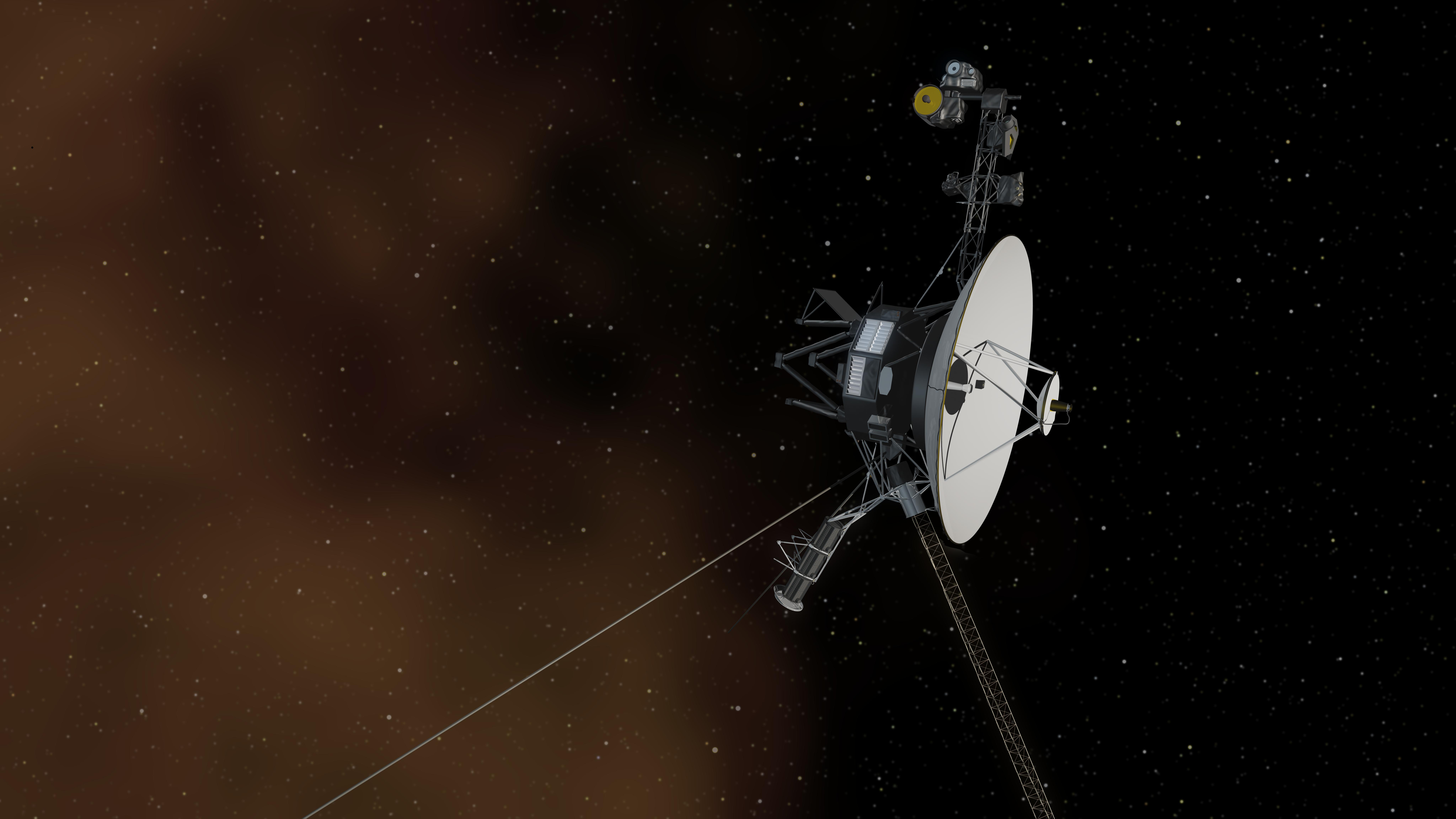
UPDATED on March 3, 2020
Voyager 2 has returned to normal operations following the anomaly on Jan. 25, 2020. The five operating science instruments, which were turned off by the spacecraft's fault protection routine, are back on and returning normal science data.
Voyager 2 Engineers Working to Restore Normal Operations
UPDATED on Feb. 5, 2020
Mission operators report that Voyager 2 continues to be stable and that communications between Earth and the spacecraft are good. The spacecraft has resumed taking science data, and the science teams are now evaluating the health of the instruments following their brief shutoff.
Engineers for NASA's Voyager 2 spacecraft are working to return the mission to normal operating conditions after one of the spacecraft's autonomous fault protection routines was triggered. Multiple fault protection routines were programmed into both Voyager 1 and Voyager 2 in order to allow the spacecraft to automatically take actions to protect themselves if potentially harmful circumstances arise. At NASA's Jet Propulsion Laboratory in Pasadena, California, engineers are still communicating with the spacecraft and receiving telemetry.
Launched in 1977, Voyager 1 and Voyager 2 are both in interstellar space, making them the most distant human-made objects in the solar system. On Saturday, Jan. 25, Voyager 2 didn't execute a scheduled maneuver in which the spacecraft rotates 360 degrees in order to calibrate its onboard magnetic field instrument. Analysis of the telemetry from the spacecraft indicated that an unexplained delay in the onboard execution of the maneuver commands inadvertently left two systems that consume relatively high levels of power operating at the same time. This caused the spacecraft to overdraw its available power supply.
The fault protection software routine was designed to automatically manage such an event, and by design, it appears to have turned off Voyager 2's science instruments to make up for the power deficit. As of Jan. 28, Voyager engineers have successfully turned off one of the high-power systems and turned the science instruments back on but have not yet resumed taking data. The team is now reviewing the status of the rest of the spacecraft and working on returning it to normal operations.
Voyager's power supply comes from a radioisotope thermoelectric generator ( RTG ), which turns heat from the decay of a radioactive material into electricity to power the spacecraft. Due to the natural decay of the material inside the RTG, Voyager 2's power budget goes down by about 4 watts per year. Last year , engineers turned off the primary heater for the Voyager 2 cosmic ray subsystem instrument in order to compensate for this power loss, and the instrument continues to operate.
In addition to managing each Voyager's power supply, mission operators must also manage the temperature of certain systems on the spacecraft. If, for example, the spacecraft fuel lines were to freeze and break, Voyager would no longer be able to point its antenna back at Earth to send data and receive commands. The temperature of the spacecraft is maintained either through the use of heaters or by taking advantage of excess heat from other onboard instruments and systems.
It has taken the team several days to assess the current situation primarily because of Voyager 2's distance from Earth - about 11.5 billion miles (18.5 billion kilometers). Communications traveling at the speed of light take about 17 hours to reach the spacecraft, and it takes another 17 hours for a response from the spacecraft to return to Earth. As a result, mission engineers have to wait about 34 hours to find out if their commands have had the desired effect on the spacecraft.
The Voyager spacecraft were built by JPL, which continues to operate both. JPL is a division of Caltech in Pasadena. The Voyager missions are a part of the NASA Heliophysics System Observatory, sponsored by the Heliophysics Division of the Science Mission Directorate in Washington. For more information about the Voyager spacecraft, visit:
https://www.nasa.gov/voyager
https://voyager.jpl.nasa.gov

Still Working After All These Years: The Voyager Plasma Wave Subsystem

NASA is always keen to highlight the space agency’s many successes, and rightly so — those who pay for these expensive projects have a right to know what they’re getting for their money. And so the news was recently sprinkled with stories of the discovery of electron bursts beyond the edge of our solar system , caused by shock waves from coronal mass ejection (CME) from our Sun reflecting and accelerating electrons in interstellar plasmas. It’s a novel mechanism and an exciting discovery that changes a lot of assumptions about what happens out in the lonely space outside of the Sun’s influence.
The recent discovery is impressive in its own right, but it’s even more stunning when you dig into the details of how it was made: by the 43-year-old Voyager spacecraft, each now about 17 light-hours away from Earth, and each carrying an instrument so simple and efficient that they’re still working all after this time — and which very nearly were left out of the mission’s science payload.
Nice Work If You Can Get It

The instrument that made the discovery, the Plasma Wave Subsystem (PWS), can trace its lineage back at least as far as 1958. That’s when Donald Gurnett, an electrical engineering freshman at the University of Iowa, took a job in the lab of Dr. James Van Allen, who had recently discovered the radiation belts surrounding Earth that now bear his name. Van Allen and his team had used a special Geiger counter on Explorer 1, the first satellite flown by the United States, and the results were both exciting and foreboding. It was clear that Earth was surrounded by high-energy charged particles, which was a truly new discovery, but it also meant traveling in space may well be lethal. Moritz recently published a deeper dive into that topic .
More information was needed, so Van Allen set Gurnett to work on instruments for future satellites to explore the environment close to Earth. The team at the University of Iowa came up with innovative digital telemetry systems to replace the simple analog telemetry links used by Explorer 1 and other early satellites. They also devised a series of space radio and plasma wave experiments, in part to explore natural very-low-frequency (VLF) phenomena known as sferics , like whistlers and the “dawn chorus”. The experiments flew on satellite Injun-3 in 1962 and beamed back enough data for Gurnett to build his Ph.D. thesis on.
The lessons learned with these early experiments boosted the nascent field of space radio and plasma wave research and informed the construction of better instruments, which were flown on multiple missions through the 1960s and early 1970s. By then, NASA was deep in the planning stages for the Voyager missions, designed to take advantage of a rare alignment of orbits that would allow a probe to visit the previously unexplored outer reaches of the Solar System with a minimum of maneuvering. Gurnett was among a group of physicists who proposed a plasma wave experiment for Voyager, based mainly on the desire to learn more about the intense radiation belts known to surround Jupiter.
The group’s first proposal for a plasma wave experiment for Voyager was rejected by NASA. It was a bitter disappointment, but the plasma wave community kept after NASA to include some kind of instrument to explore Jupiter’s energetic environment. In 1973, as the clock was ticking to finalize the science payload design for Voyager, Gurnett made a compromise proposal for a plasma wave experiment. The instrument would literally piggyback on an experiment that had already been accepted: the Planetary Radio Astronomy (PRA) experiment. It would share the “rabbit ear” antennas that would be built for the PRA, with a compact spectrum analyzer attached to the enclosure holding the PRA receiver. Mainly on the strength of Gurnett’s proposal, plus the fact that the plasma wave experiment would use only 1.6 Watts of Voyager’s limited power and add only 1.4 kg of mass, NASA accepted the proposal. Soon thereafter, the Plasma Wave Subsystem, which was entirely built at the University of Iowa, was on its way to the outer planets and beyond.
Simple by Design
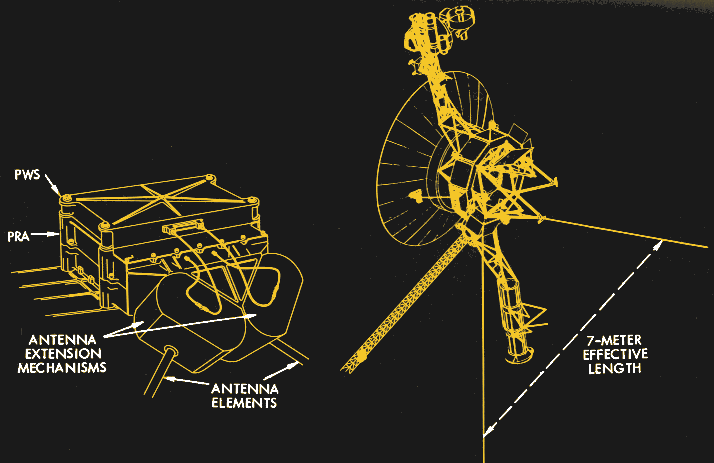
That the design of the PWS is so simple is probably the key to its success, and has a lot to do with why it’s still running on both Voyagers almost 50 years after launch. The antennas were designed for the PRA experiment but are adequate for measuring the electrical fields of plasma waves (the rejected original proposal included a magnetometer to allow study of the magnetic components of plasma waves). Each element of the antenna is 10 meters long when deployed, set 90° apart. For the PRA experiment, the antennas act as a pair of monopoles, but for PWS they are connected as a balanced dipole.
Storing and deploying 10-meter-long antenna elements in space requires some clever thinking. The PRA/PWS antenna used basically the same technique employed on IMP-6, a satellite in the early 70s that needed antennas up to 45 meters in length. The Storable Tubular Extendable Members antenna, or STEM, was used for both IMP-6 and, in considerably shortened form, on Voyager. It consisted of a sheet of beryllium copper rolled onto a spool, a drive motor, and a forming die. The copper sheet had been formed into a tube before being rolled flat on the spool, and when extended through the die, snapped back into a rigid tube.
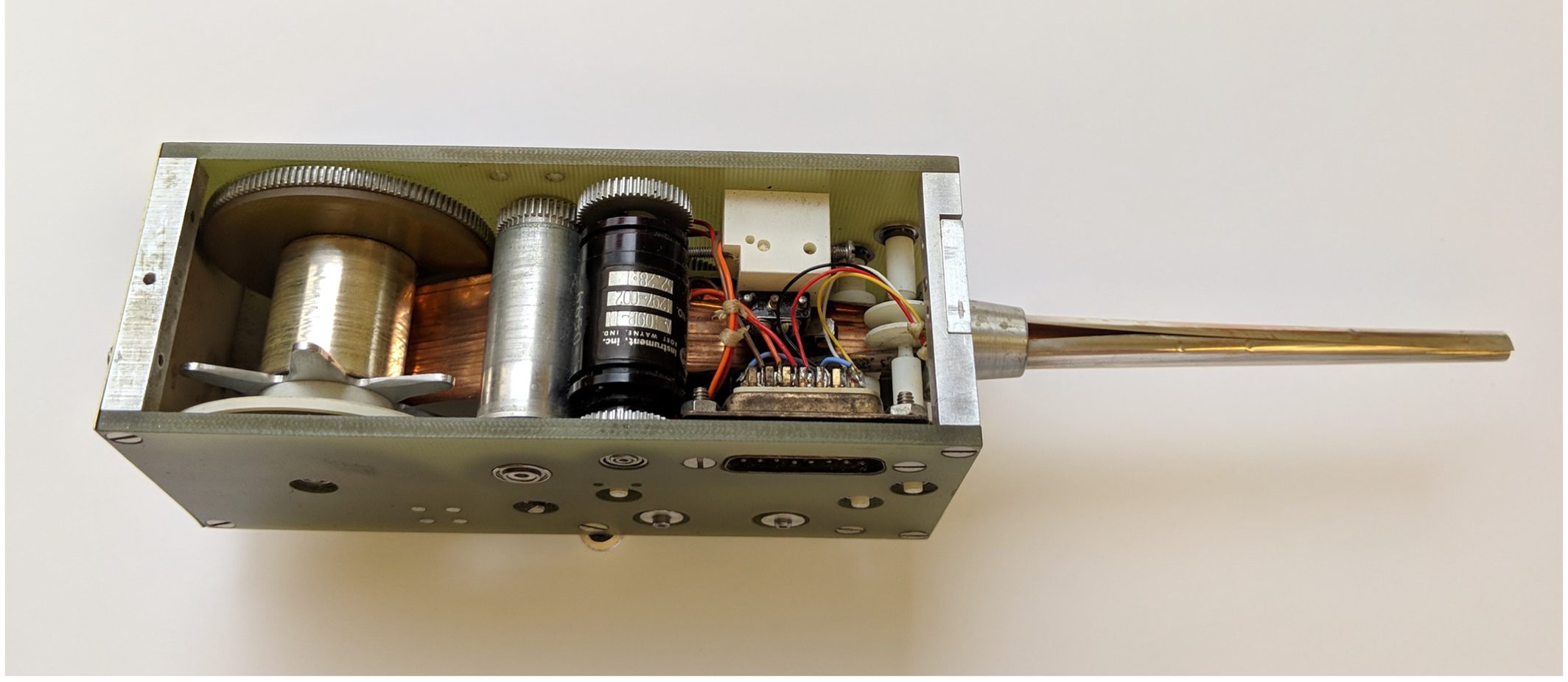
The PWS instrument was also simple by design. Each antenna is connected to a preamplifier with a selectable 40 dB attenuator, to prevent the intense Jovian radiation from swamping the electronics. The output of each preamp feeds into a differential amplifier, whose output is proportional to the voltage difference between the two antennas. This signal is passed through a notch filter to remove noise from Voyager’s 2.4-kHz switching power supply before being fed to a 16-channel spectrum analyzer that covers 10 Hz to 56.2 kHz. The 16 filters in the spectrum analyzer generated output signals from 0 to 3 volts, which are sent to the spacecraft’s Flight Data Subsystem for encoding.
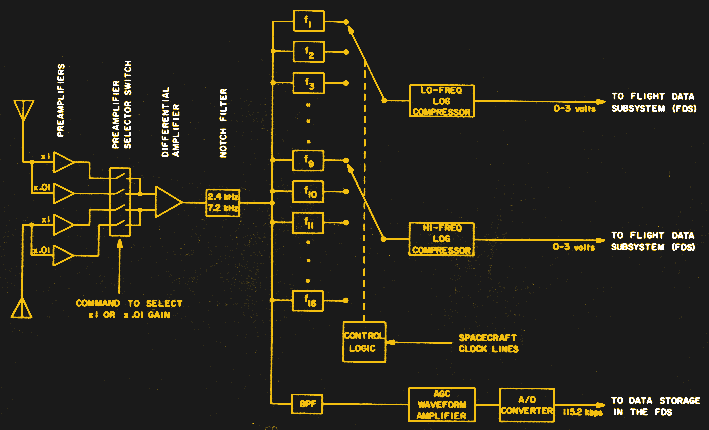
The Long Dark
After the long journey past the orbit of Mars and through the asteroid belt, the PWS finally got a chance to prove itself. During the high-speed flybys of each gas giant, calculated to provide a gravitational assist to the next waypoint, the PWS performed a complete scan through all 16 channels every four seconds. The resulting data was stored on the Data Tape Recorder , or DTR, and queued for streaming back to Earth.
Once the Voyager twins had completed their survey of the outer planets in 1989, the Voyager Interstellar Mission began. Planning for the exploration of the lonely black void into which both spacecraft now hurtled had been in the works for quite some time, and it was clear that the PWS would play a major role in whatever discoveries lie ahead. The complex and power-hungry polarimeters, spectrometers, and imaging systems, designed to gather data mainly during planetary encounters, were largely switched off, leaving more power available to the simpler particle detectors and magnetometers, as well as the PWS, to continue exploring the depths of space.
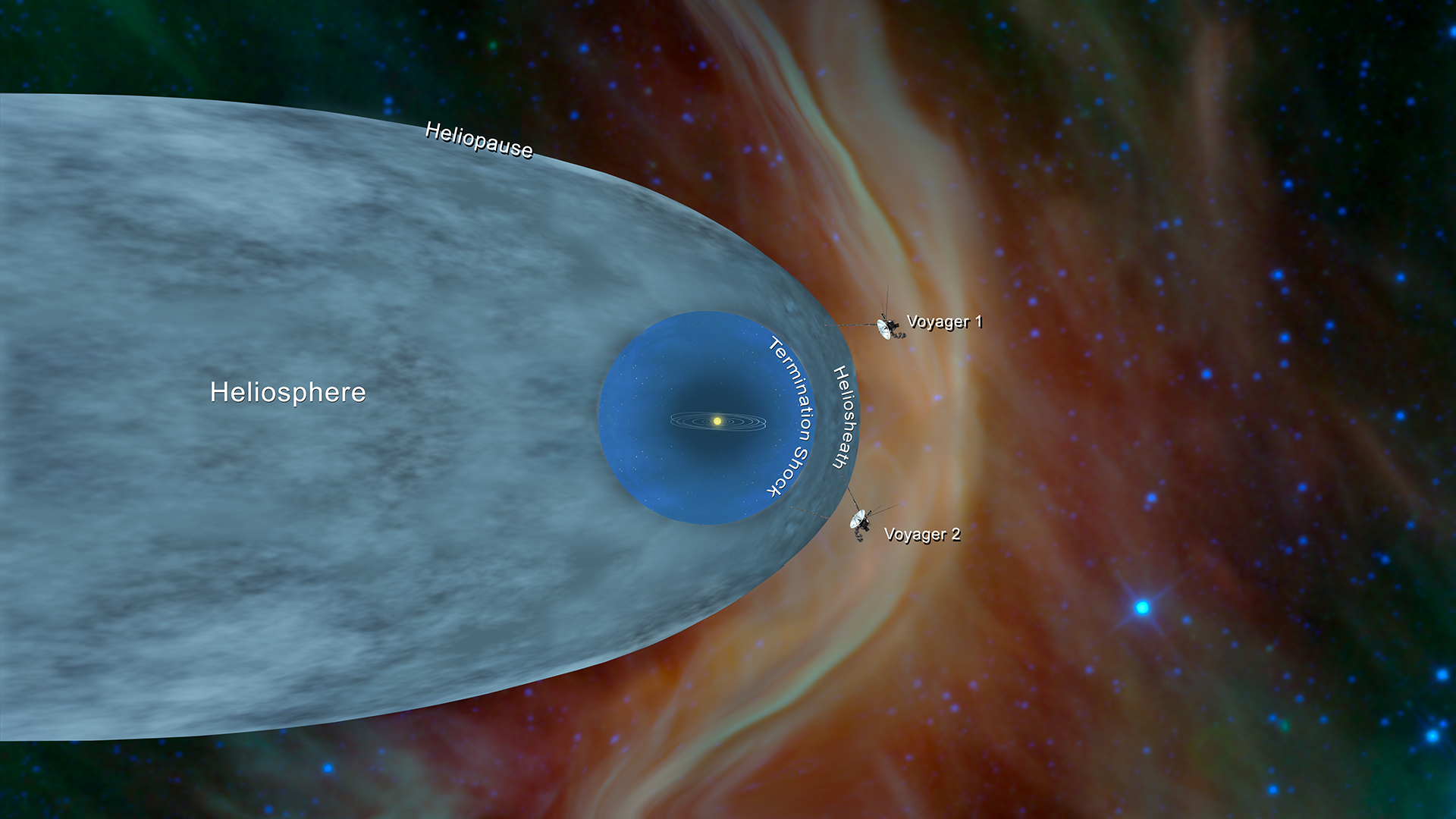
Both Voyagers eventually passed through the boundary where the hot, charged particles streaming out from the Sun, or solar wind, is pushed back by the cooler plasmas of the interstellar medium. The transition through the various layers of rarified plasmas at the edge of the solar system were all noted by PWS data, as was the passage of each spacecraft through the heliopause and into interstellar space, which was marked by a 40-fold increase in plasma density. The PWS was also key to the recent electron-burst discovery.
The Plasma Wave Subsystem, included on the Voyager mission at the last minute, has performed admirably for the last 43 years and has provided us with a detailed picture of what lies at the edge of our solar system. Eventually, and soon now, the plutonium in the Voyager twins’ radioisotope thermal generators will decay to the point where there’s not enough power to keep everything running, but with any luck the Plasma Wave Subsystem will be one of the last instruments to enter its long interstellar sleep.

49 thoughts on “ Still Working After All These Years: The Voyager Plasma Wave Subsystem ”
Yayy! Thanks for writing the article.
I see Don Gurnett is still active within the scientific academic community!
https://now.uiowa.edu/2020/12/voyager-spacecraft-detect-new-type-solar-electron-burst
How many more years of Data will we get before the Voyagers go dark for good?
Reports indicate they will finally stop transmitting any and all data between 2028-2034. Mostly, the time frame is described as, ‘Late 2020’s to early 2030’s.’
I keep getting more and more impressed by the voyager probes for esch article I read. The whole project was a monumental success. And on top of that we are still receiving very useful scientific data. Absolutely incredible. That disc they attached to the probes showing our planets position might not have been the best idea though…
Happy new year!
I have always believed the Voyagers are the best scientific achievement of humans, and profoundly primitive “throw this rock as far as you can.”
They’re both now the furthest objects from Earth. Older than the average person.
Astounding.
Best tax dollars I ever spent.
That disc got everybody thinking and talking about the Voyager missons. I suspect that was the main objective all along.
Helped V’Ger find his way home. Talk about a return on an investment.
Lol … Nice
As a species we are not even out of the playpen. Who would want to beat up a bunch of children?
I’d figure that the “die” part that makes the antenna into the tube is not all that dissimilar from that bagel machine we saw earlier in the week.
The problem is the high temperature silicon-germanium thermoelectric couples have dropped in efficiency over time.
At launch: 3 RTG’s in each voyager spacecraft ~4.5kg of plutonium-238 per RTG (~0.57 watts of thermal power is generated per gram of plutonium-238) Each RTG generated about 2400 Watts of thermal power hot junction temperature was 1273 K (1000 °C, 1832 °F) cold junction temperature of 573 K (300 °C, 572 °F) Collectively, the RTGs supplied each Voyager spacecraft with 470 watts. => each RTG was about ~6.5% efficient at launch
Now: The half life of plutonium-238 is 87.7 years After 43 years: 1 – ( 0.5 ^ (43/87.7)) ~= 0.288 There nearly 29% less plutonium-238 than when the RTG’s launched. So each RTG’s output has dropped down to about ~1700 Watts of thermal power The total electrical power out, currently drops by about 4 watts per year so it, is down to about ~234 watts Which would imply that the TEG’s are now about are about 4.6% efficient
Part of that drop is because the the hot junction temperature is now lower, but the biggest loss in efficiency is the TEG’s failing gracefully.
I would imagine that it’s the junction materials diffusing into each other.
Chemistry in action!
And I’m sure that there was also some loss of efficiency due to 47 years cumulative damage from cosmic radiation. And I’m sure some from other elements in the Plutonium-238 which is not 100% pure, “… could not be produced to the specifications, (… snip … which ultimately meant ) loosening of the specifications”
Since I tend to rain on a parade a lot, I will now say that Voyagers are the pinnacle of American science and engineering (with Apollo). They are something that should make USA proud. A real beacon as to what should be pursued, and what improves American image immensely.
I’m still worried the aliens get the wrong impression though, we yeeted out nudes and a mix-tape.
When the aliens see the pictures on the disc I imagine they will be so different from us it will be like the joke “What did the elephant say to the naked man? ‘How do you breathe through that thing?'”
The stuff we’ve sent to Mars is going pretty good as well.
I agree. Excellent job it was, and it still is.
It’s kinda funny how back then, in the cold war era, the mission was perceived as a archivement of humanity as a whole (the golden record containing material of the whole world), whereas space exploration today is all about the glory of the USA (and other nations).. 🙄
PS: Don’t get me wrong, I believe we’re generally all proud of USA/NASA/JPL etc., but for foreigners like me this patriotism feels a bit awkward at times, I guess. 😉 That being said, it’s no offense. You have the right to be proud, of course. Especially in this case. Voyager is one of the few things that represents humanity’s best. 😎 Like Arecibo used to be, it’s also a symbol. It proves that we can do anything if we really try. That we truely can reach the stars. And that money is not everything in life, that we can make things last. And that 1970s tech was great! 😁 Maybe Voyager will be a good reminder for this in the upcoming era of commercialization of space travel.
Last, but not least, let’s also remember things wouldn’t have been possible without the pioneers of other times and places around the world and the individuals contributing to the project. Whoever they may be or may were, wherever they came from, who ever they worked for, wherever they went. Some of them are still missing in the books of history, likely. It’s the small interpersonal things in life that often matter, but are rarely valued or written down.
I’m not American either. But I like to praise them when praise is deserved, in ever-present hope they will do more of what’s good for humanity. If that requires flag-waving patriotism, that’s fine. Patriotism is good when it leads to good outcome.
Happy New Year to everyone.
Ah, I see. Makes sense to me.
Let us not forget the two Pioneers who ran off first.
Good point, as we have five probes hurling out of the solar system, if we count the relative newcomer…
17 light years from earth…. Each! Does that mean in 43 years each Voyagers have been travelling at half the speed of light?!? Calling b.s., sorry mates!
Light Hours, not light years.
Its 17 light HOURS not years. So its only gone 11.4 billion miles in 43 years or 30,265 miles an hour average. Thats around 8.5 miles per sec.
A far cry from 186,300 miles per sec that the speed of light is lol
As the article says, they’re 17 light-hours away, not lightyears.
The craft are 17 light HOURS from Earth.
17 light-hours
That kind of engineering is long gone. Thoughtful, long lasting, humble. Now it’s ‘look at me, I’m brilliant for 2 seconds but it paid.’.
In my humble opinion, the 1970s were truely special in this respect. Let’s just look at the 555/LM386/741 ICs, Cosmac/RCA CDP1802, the Zilog Z80 or the AO7 satellite.. These were elegant and simple, but not primitve. And they are still around. Even 1950s tubes like the EF95 (6К8П, 6ES6) stood the test of time.
If we really want to reach the heavens, we need to agree to technology and concepts that last. So better not constantly rush out highly complex processors and transmission protocols into space, but rather sit down a moment, think and work out data protocols and radio technology that lasts. Voyager teached us that missions can last longer than one human life time and that we need to support radio transmitters and data protocols for a long time.
So better think ahead and design simple, but elegant ways of accomplishing things. Instead of re-inventing the wheel, “we” could make new Voyagers based upon the old designs. With todays wisdom and a little bit of refurbishing, the 1970s technology could be made more power effiecient or even longer lasting. And this involves not replacing the old processor chips by the current gen, no. Instead, it would be worth a try to make modern replicas of the older proccesors. These replicas could be “cleaner” more accurately built, with less errata and power consumption. But at the same time more robust (space hardened) due the use of better materials. Minitaturization is also a key, but “we” should no overdoo it. If structures are becoming too small, they will be the victims to radiation. That’s were 1970s technology had its advantages. It was discrete and massive. Also, redundancy was a key element (three units performing same tasks).
I like your thinking. That approach has another advantage: with simple architecture, it is difficult to slip-in hardware backdoors.
I like your comments…we( I guess the Western world) really should be throwing much more research back into radio…we know for example that in China, thousands literally thousands of electrical engineers are working in RF fields…
If society didn’t buy it people wouldn’t make it – bakelite phones happily lasted for a century but I don’t see anyone chopping in their iPhone for one.
Voyager was built that way because that was the available technology and systems of the time, much like ancient buildings / bridges etc. tend to be excessively solid because that was the best way to guarantee it wouldn’t fall down at the time before things like FEA and powerful computers / CAD existed.
New things aren’t awful, they’re incredible – maybe stop sniping at them and look for the positives.
Actually the power source is call the Multihundred-Watt radioisotope thermoelectric generator, “The Helipak”. Invented by the grandfather along with the SNAP-27.
Given the state of the science and engineering when this magnificent project was conceived and implemented the fact that it is still functioning is a massive credit to all involved. I have a real concern that today everything is so complex that its tendency to not work properly or fails is much greater than the likes of Voyager. I would put part of the success of SpaceX down to a much more minimalist solution to the very difficult problem of putting things into space. Everything about Voyager is exceptional from getting it approved, doing the computation to pull off all the slingshots, deciding what kit to use, putting it together and getting it launched in window that was not going to be there for another 160 years holds many lessons for us all. The reality is that today it is too easy to overcomplicate “stuff”, the really clever bit is to keep it simple. To Don and all the other people involved in Voyager you have set us an example we should learn from and not forget. As we fight for the survival of our planet one thing is certain, if we don’t keep it simple we will fail!
Can you just imagine being retired and in your 70s and seeing something you made in your 30s still making headlines for science?
What an amazing project to be a part of. I’m just in awe.
Something similar happened to the makers of the AMSAT OSCAR 7 satellite, I suppose. The satellite was started in the 1970s, -like the Voyagers-, went silent in the 1980s and came back to life in the 2000s. https://www.amsat.org/two-way-satellites/ao-7/
There are SIX (most likely) possible endings for the Voyager spacecraft, all of them extremely far into the future. 1) They will speed through interstellar space, never being found, virtually forever. 2) They will be captured by another sun and go into orbit around it, also forever. 3) A rogue comet, asteroid, or other piece of space rock will run into them and destroy them. 4) They will be captured in orbit by another planet or moon far from our Solar System. 5) They will be pulled into the gravity well of a planet and destroyed on entry. 6) They will be discovered by aliens and possibly decoded.
Number six is extremely unlikely, but that’s what the scientists were hoping would happen. And if wonder what happens after THAT…just watch the film ‘Independence Day’. Just kidding on that last bit. :)
or they will just decode it without touching it, that way aliens #2 will not know that aliens #1 decoded it and there will be no need for unfriendly encounters between the two different sub-species.
its like finding a pool of blood next to a broken knife-handle on the beach, you miiight not want to put your fingerprints on it or even be seen reacting as if you noticed it. might send in a drone/satellite/robot to do the sluething.
If aliens ever come this way, I see only a few solutions:
1, The’re friendly and want company, and help us to get nearer to their level. 2. The’re interested in a habitable planet and we get trampled like ants. 3. They come here with friendly intentions but are so annoyed by the mess we make of everything that they trample us like ants anyway. 4. the’re so alien that there is no predicing what they would do.
I do know that movies like indepence day, War of theWolds, etc are so completely unrealistic that the’re not even “entertainment”, like most hollywood stuf, it’s just for dulling the masses.
I love the spacecraft graphic at the top of the article but am compelled to point out that’s a Pioneer 10-11 and not a Voyager.
By the way, back in the day, the pictures of Voyager 2 were re-transmitted via SSTV by amateur radio people, which also held conversations/conferences via SSTV. This was in a time when SSTV was still mostly in b/w format, similar to Robot-8. https://www.qsl.net/kd2bd/sstv.html https://jplarc.ampr.org/calling/1981/sep/sep81.html
I see comments about going back to simpler technology – nonsense! Voyager was the most advanced design using the best tools available at the time. For this old-timer, one of the most impressive achievements was seeing a pair of Falcon heavy boosters return to earth and land upright simultaneously! That took some serious software and planning!
Not exactly going back I’d say – learning from it, improving it. Over the last years our modern day technology became rather fragile, over-engineered.
Our cars and trains can’t handle a bit of summer heat or snow anymore, for example. They became sunshine technology, literally. Or just think of stationary telephones. They used to be powered by the landline.
Or analogue AM/FM radio. It worked entirely independently of the internet and required no microchips. You could build your own easily, even.
It just needs one bigger solar event and our cities become dark (power outage).
In space, were radiation is very strong and never making a pause, things must be very sturdy. The Voyagers and Pioneers are veterans, but also lasted the longest so far. That’s why we should appreciate it’s simpler technology. – It has stood the test of time after all.
(That doesn’t mean we should stop sending out probes with newer technology, of course. It barely means that we should also consider to use Voyager-derived technology in future missions.)
https://futurism.com/nasas-twin-voyager-probes-are-the-most-important-spacecraft-ever-launched
Let’s see if New Horizons will last as long, too. :)
My view is the spectacular success of SpaceX is that they have kept thigs “Simple” compared to NASA. The size of their facility at Cape Canaveral is very small. SpaceX builds a very large proportion of its equipment in house avoiding the bureaucracy of multiple contractors. The technology available for Voyager inherently limited how complex it could be. The engineers had to be super smart to do what they did. A spin off of this has been the very long working life of Voyager. Today it is too easy to use excessive complexity to cover up the fact that you didn’t get the basics right at the beginning. Compare Hubble to James Web and you start to see the risks complexity create.
Leave a Reply Cancel reply
Please be kind and respectful to help make the comments section excellent. ( Comment Policy )
This site uses Akismet to reduce spam. Learn how your comment data is processed .
Never miss a hack
If you missed it.

Mining And Refining: Uranium And Plutonium

Programming Ada: First Steps On The Desktop

The Hunt For MH370 Goes On With Barnacles As A Lead

MXM: Powerful, Misused, Hackable

VCF East 2024 Was Bigger And Better Than Ever
Our columns.

Welcome Back, Voyager

Hackaday Podcast Episode 268: RF Burns, Wireless Charging Sucks, And Barnacles Grow On Flaperons

This Week In Security: Cisco, Mitel, And AI False Flags

Keebin’ With Kristina: The One With The Transmitting Typewriter

Supercon 2023: Alex Lynd Explores MCUs In Infosec
By using our website and services, you expressly agree to the placement of our performance, functionality and advertising cookies. Learn more
NTRS - NASA Technical Reports Server
Available downloads, related records.

Radioisotope thermoelectric generators, abbreviated RTGs, have operated in space for a total combined time of more than 300 years. Not a single thermocouple has ever ceased producing power.
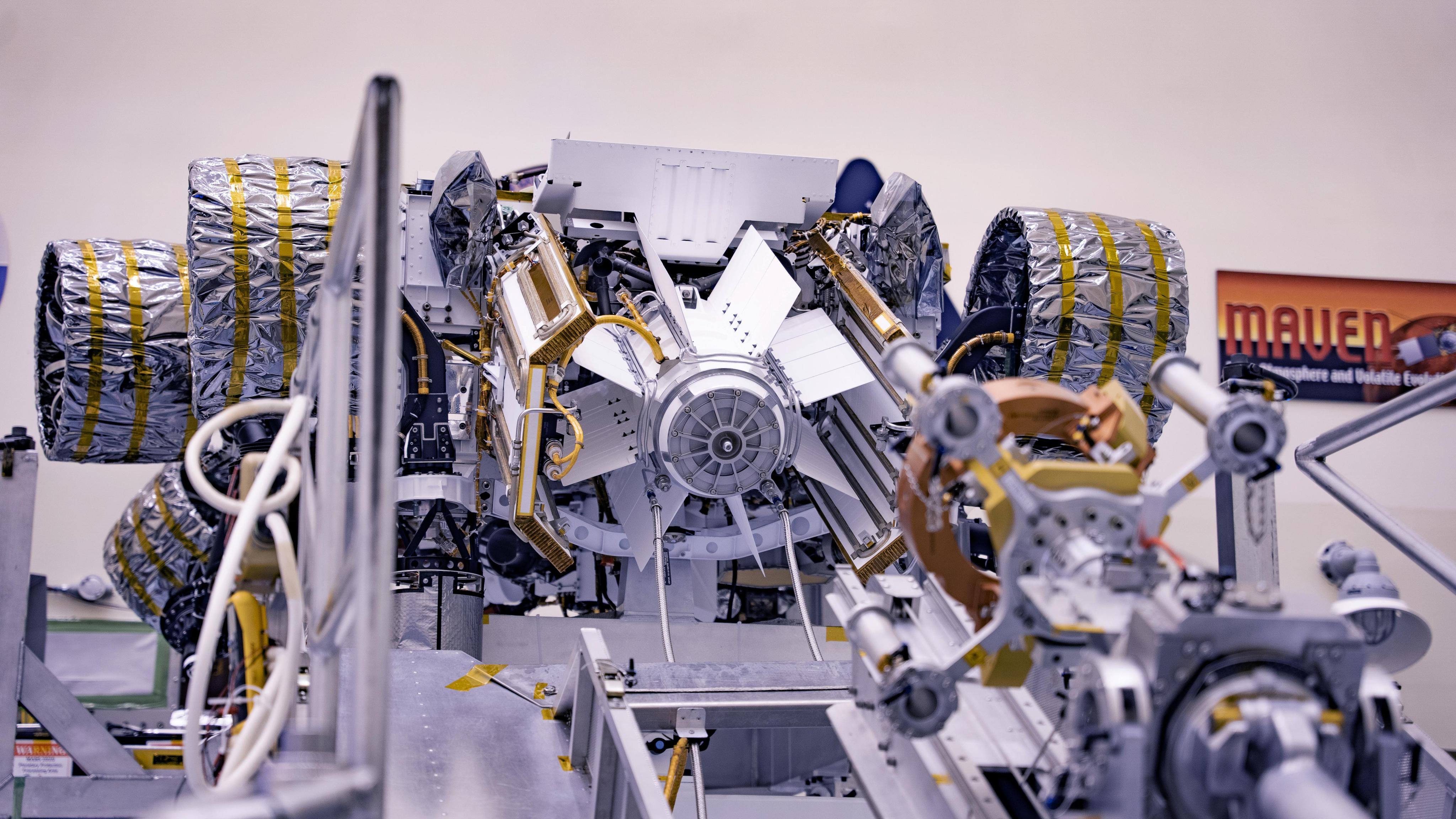
Radioisotope Thermoelectric Generator s
Radioisotope thermoelectric generators , or RTGs , provide electrical power for spacecraft by converting the heat generated by the decay of plutonium-238 (Pu-238) fuel into electricity using devices called thermocouples. Since they have no moving parts that can fail or wear out, RTGs have historically been viewed as a highly reliable power option.
Thermocouples are common in everyday items that must monitor or regulate their temperature, such as air conditioners, refrigerators and medical thermometers. The principle of a thermocouple involves two plates, each made of a different metal that conducts electricity. Joining these two plates to form a closed electrical circuit while keeping the two junctions at different temperatures produces an electric current. Each of these pairs of junctions forms an individual thermocouple. In an RTG, the radioisotope fuel heats one of these junctions while the other junction remains unheated and is cooled by the space environment or a planetary atmosphere.
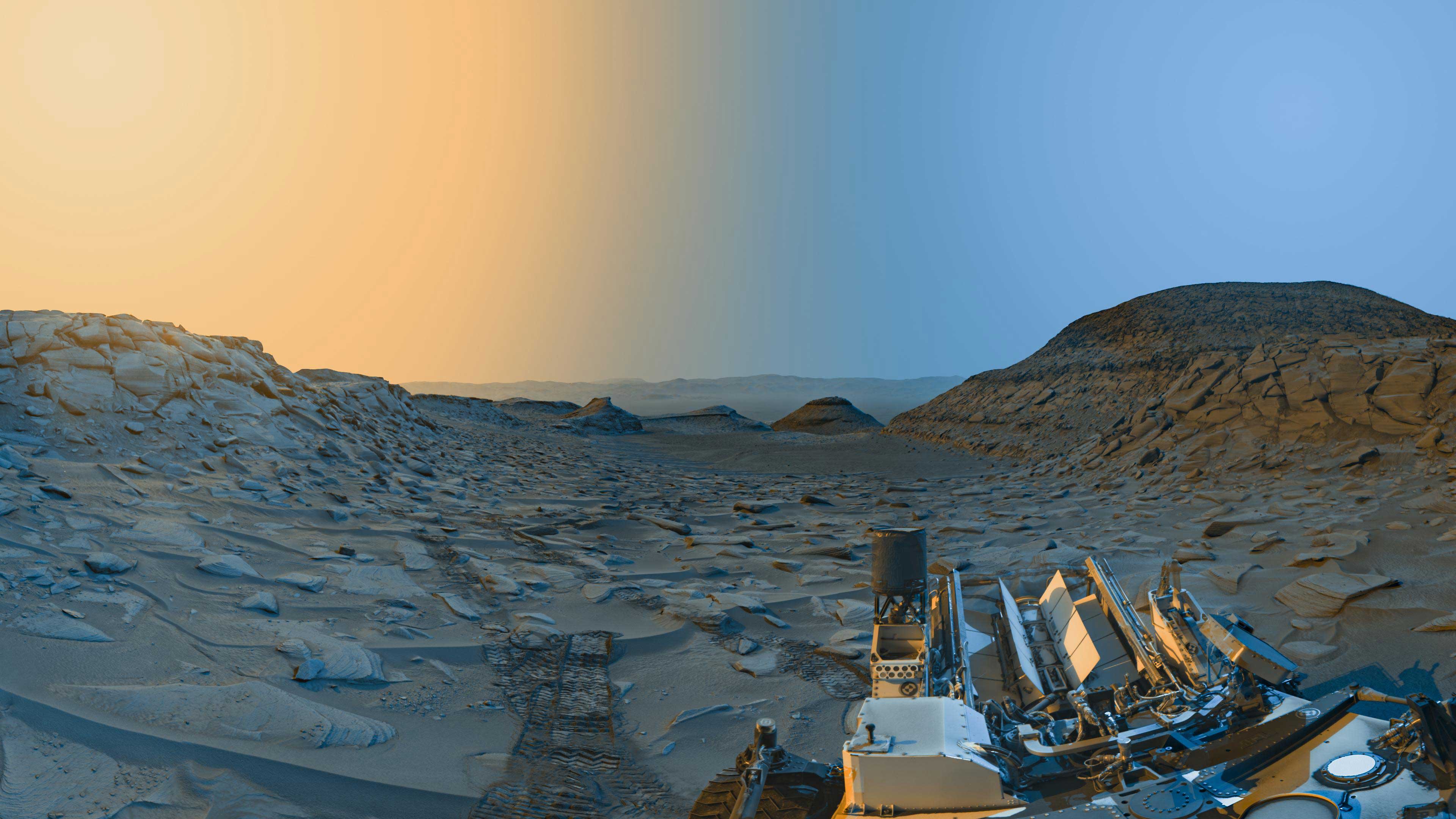
Before and After
Curiosity's 'Postcard' of 'Marker Band Valley'
June 13, 2023
Multi-Mission Radioisotope Thermoelectric Generator (MMRTG)
The current RTG model is the Multi-Mission Radioisotope Thermoelectric Generator , or MMRTG . It is based on the type of RTG flown previously on the two Viking landers and the Pioneer 10 and 11 spacecraft (the SNAP-19 RTG). It is designed to be used in either the vacuum of space or within the atmosphere of a planet. The excess heat energy from an MMRTG can be used as a convenient and steady source of warmth to maintain proper operating temperatures for a spacecraft and its instruments in cold environments.
Previous Generations of RTGs
Systems for nuclear auxiliary power-19b (snap-19b) rtg.
Power source for Nimbus III meteorological satellite.
- Output 28.2 Watts electric (or We) at beginning of mission.
- NASA's first application of a radioisotope power system (RPS).
- Launch vehicle failure forced destruction by range safety officer.
- Spacecraft and upper stage sank in California's Santa Barbara Channel.
- RTGs recovered and fuel reused for Nimbus III.
SNAP-19 RTG
Power source for the Viking 1 and 2 Mars landers and the Pioneer 10 and 11 spacecraft.
- Output 40.3 Watts electric (Pioneer) and 42.6 Watts electric (Viking) at beginning of mission,
- Modified version of SNAP-19B.
- Pioneer 10 & 11 design lifetime was five years; spacecraft continued to communicate with Earth for 30 and 22 years respectively.
- Viking 1 & 2 operational requirement was 90 days; landers operated for six and four years respectively.
SNAP-27 RTG
Power source for the Apollo Lunar Surface Experiment (ALSEP) packages carried to the Moon by Apollo crews. Astronauts on Apollo missions 12, 14, 15, 16 and 17 deployed RTG-powered ALSEPs.
- Output 70 Watts electric at beginning of mission.
- Two-year design lifetime. All deployed units operated five to eight years until ALSEP stations were shut down in 1977.
Multi-Hundred Watt RTG (MHW-RTG)
Power source for Voyager 1 and 2 spacecraft
- Output 158 Watts electric at beginning of mission.
- The RTGs still operating over 45 years later on the edge of interstellar space.
General Purpose Heat Source RTG (GPHS-RTG)
Power source for the Galileo, Ulysses, Cassini, and New Horizons spacecraft.
- Output 292 Watts electric at beginning of mission
- A total of 18 general purpose heat source (GPHS) modules are stacked together to provide the heat source for each GPHS RTG.
- New Horizons RTG is still operating and enabled an extended mission deeper into the Kuiper Belt beyond Pluto.
- Galileo operated for nearly 14 years, while Ulysses and Cassini functioned for nearly 19 years in space.
Fact Sheets
Nasa facts: next generation radioisotope thermoelectric generators, nasa facts: multi-mission radioisotope thermoelectric generator (mmrtg).
(969.27 KB)
Archival Content: Enhanced Multi-Mission Radioisotope Thermoelectric Generator (eMMRTG) Concept
(182.38 KB)

NASA manages to fix Voyager's garbled data problem, even though it's more than 15 billion miles away
B ack in November, NASA's second longest-running spacecraft Voyager I began sending data that made no sense whatsoever. Instead of information about its status and what various sensors were recording, all the scientists got was a meaningless repeated pattern . Well, after much head-scratching and hard work, engineers have fixed the issue and confirmed that Voyager I is transmitting properly once more, from the depths of interstellar space.
Launched in 1977, Voyager I was part of a twin spacecraft mission to study the gas planets, flying past Jupiter and then Saturn, before heading off out into the unknown. Powered by a radioisotope thermoelectric generator (RTG), it continued to send back data to Earth and in 2012, it crossed the heliopause and officially entered interstellar space.
It's fair to say that nobody really expected the spacecraft to continue functioning for so long but despite a few glitches along the way, it's continued to provide valuable information about the nature of our Solar System.
That was until November 2023, when its Telemetry Modulation Unit (TMU) appeared to have failed, as it just sent a constantly repeating pattern of data. NASA's engineers ultimately discovered that the TMU was working as intended—the issue was one of the ancient memory chips for the Flight Data Subsystem (FDS) had failed, either due to a high-energy particle wrecking it or just through over four decades of wear and tear.
Since that chip stored instructions for how the FDS should communicate with the TMU, its loss meant the latter had no way to work properly. The two Voyager spacecraft were some of the first ever to use volatile memory to store data, so it's remarkable that they've lasted as long as they have. But with the problem identified, a solution could be developed and it was about essentially figuring out which code had been lost and then resending it to be stored on another memory chip.
Not that it would be a quick fix. Voyager I is over 15 billion miles away and it takes around 22.5 hours for a radio signal to reach it and then another 22.5 hours for any response to return to Earth—imagine clicking on a desktop icon and waiting for nearly two days for it to activate, and you'll get a sense of how challenging it is to work with the spacecraft.
NASA can only send part of the required instructions in any one signal but the first batch was sent on April 18. Two days later, a response was received indicating that the memory relocation had gone as planned and the spacecraft could now correctly report its status.
Over the next few weeks, the engineers will continue to move the code for the FDS into other memory locations and once complete, Voyager I will be able to send scientific data back.
At some point in the next few years, the RTG will no longer have sufficient radioactivity to power the spacecraft's transmitter and it will fall silent for good. By 2036, even if it does somehow continue to work, Voyager I will be too far for NASA's Deep Space Network .
We'll probably never know the ultimate fate of the incredible machine but its discoveries have been an astonishing testament to the skill and ingenuity of NASA scientists and engineers.
Somehow I doubt anything in my current PC will last half as long but if it does start going wonky, I think I know who might be best at fixing it.

- Election 2024
- Entertainment
- Newsletters
- Photography
- Personal Finance
- AP Investigations
- AP Buyline Personal Finance
- AP Buyline Shopping
- Press Releases
- Israel-Hamas War
- Russia-Ukraine War
- Global elections
- Asia Pacific
- Latin America
- Middle East
- Election Results
- Delegate Tracker
- AP & Elections
- Auto Racing
- 2024 Paris Olympic Games
- Movie reviews
- Book reviews
- Personal finance
- Financial Markets
- Business Highlights
- Financial wellness
- Artificial Intelligence
- Social Media
NASA hears from Voyager 1, the most distant spacecraft from Earth, after months of quiet
This illustration provided by NASA depicts Voyager 1. The most distant spacecraft from Earth stopped sending back understandable data in November 2023. Flight controllers traced the blank communication to a bad computer chip and rearranged the spacecraft’s coding to work around the trouble. In mid-April 2024, NASA’s Jet Propulsion Laboratory declared success after receiving good engineering updates. The team is still working to restore transmission of the science data. (NASA via AP)
- Copy Link copied
CAPE CANAVERAL, Fla. (AP) — NASA has finally heard back from Voyager 1 again in a way that makes sense.
The most distant spacecraft from Earth stopped sending back understandable data last November. Flight controllers traced the blank communication to a bad computer chip and rearranged the spacecraft’s coding to work around the trouble.
NASA’s Jet Propulsion Laboratory in Southern California declared success after receiving good engineering updates late last week. The team is still working to restore transmission of the science data.
It takes 22 1/2 hours to send a signal to Voyager 1, more than 15 billion miles (24 billion kilometers) away in interstellar space. The signal travel time is double that for a round trip.
Contact was never lost, rather it was like making a phone call where you can’t hear the person on the other end, a JPL spokeswoman said Tuesday.
Launched in 1977 to study Jupiter and Saturn, Voyager 1 has been exploring interstellar space — the space between star systems — since 2012. Its twin, Voyager 2, is 12.6 billion miles (20 billion kilometers) away and still working fine.
The Associated Press Health and Science Department receives support from the Howard Hughes Medical Institute’s Science and Educational Media Group. The AP is solely responsible for all content.
share this!
April 22, 2024
This article has been reviewed according to Science X's editorial process and policies . Editors have highlighted the following attributes while ensuring the content's credibility:
fact-checked
trusted source
NASA's Voyager 1 resumes sending engineering updates to Earth

For the first time since November, NASA's Voyager 1 spacecraft is returning usable data about the health and status of its onboard engineering systems. The next step is to enable the spacecraft to begin returning science data again. The probe and its twin, Voyager 2, are the only spacecraft to ever fly in interstellar space (the space between stars).
Voyager 1 stopped sending readable science and engineering data back to Earth on Nov. 14, 2023, even though mission controllers could tell the spacecraft was still receiving their commands and otherwise operating normally. In March, the Voyager engineering team at NASA's Jet Propulsion Laboratory in Southern California confirmed that the issue was tied to one of the spacecraft's three onboard computers, called the flight data subsystem (FDS). The FDS is responsible for packaging the science and engineering data before it's sent to Earth.
The team discovered that a single chip responsible for storing a portion of the FDS memory—including some of the FDS computer's software code—isn't working. The loss of that code rendered the science and engineering data unusable. Unable to repair the chip, the team decided to place the affected code elsewhere in the FDS memory. But no single location is large enough to hold the section of code in its entirety.
So they devised a plan to divide the affected code into sections and store those sections in different places in the FDS. To make this plan work, they also needed to adjust those code sections to ensure, for example, that they all still function as a whole. Any references to the location of that code in other parts of the FDS memory needed to be updated as well.

The team started by singling out the code responsible for packaging the spacecraft's engineering data. They sent it to its new location in the FDS memory on April 18. A radio signal takes about 22.5 hours to reach Voyager 1, which is over 15 billion miles (24 billion kilometers) from Earth, and another 22.5 hours for a signal to come back to Earth. When the mission flight team heard back from the spacecraft on April 20, they saw that the modification had worked: For the first time in five months, they were able to check the health and status of the spacecraft.
During the coming weeks, the team will relocate and adjust the other affected portions of the FDS software. These include the portions that will start returning science data.
Voyager 2 continues to operate normally. Launched over 46 years ago, the twin Voyager spacecraft are the longest-running and most distant spacecraft in history. Before the start of their interstellar exploration, both probes flew by Saturn and Jupiter, and Voyager 2 flew by Uranus and Neptune.
Provided by NASA
Explore further
Feedback to editors

DNA study of Avar cemetery remains reveals network of large pedigrees and social practices
2 hours ago

Global study shows a third more insects come out after dark
Apr 27, 2024

Cicada-palooza! Billions of bugs to blanket America

Getting dynamic information from static snapshots

Ancient Maya blessed their ballcourts: Researchers find evidence of ceremonial offerings in Mexico

Optical barcodes expand range of high-resolution sensor
Apr 26, 2024

Ridesourcing platforms thrive on socio-economic inequality, say researchers

Did Vesuvius bury the home of the first Roman emperor?


Florida dolphin found with highly pathogenic avian flu: Report

A new way to study and help prevent landslides
Relevant physicsforums posts, quasi-moons.
3 hours ago
Black Holes Colliding Exactly Head On
8 hours ago
Need help simplifying standard error formula for redshift
Our beautiful universe - photos and videos.
Apr 25, 2024
Solar Activity and Space Weather Update thread
'devil' comet visible tonight 21.04.24.
More from Astronomy and Astrophysics
Related Stories

Engineers working to resolve issue with Voyager 1 computer
Dec 13, 2023

NASA hears signal from Voyager 2 spacecraft after mistakenly cutting contact
Aug 1, 2023

NASA listens for Voyager 2 spacecraft after wrong command cuts contact
Jul 31, 2023

NASA's Voyager team focuses on software patch, thrusters
Oct 20, 2023

NASA's Voyager will do more science with new power strategy
Apr 27, 2023

Engineers investigating NASA's Voyager 1 telemetry data
May 18, 2022
Recommended for you

Japan's moon lander wasn't built to survive a weekslong lunar night. It's still going after 3
Apr 24, 2024

Simulated microgravity affects sleep and physiological rhythms, study finds
Apr 22, 2024

'Tube map' around planets and moons made possible by knot theory
Apr 17, 2024

NASA's Ingenuity Mars helicopter team says goodbye—for now

NASA confirms mystery object that crashed through roof of Florida home came from space station
Apr 16, 2024

NASA is seeking a faster, cheaper way to bring Mars samples to Earth
Let us know if there is a problem with our content.
Use this form if you have come across a typo, inaccuracy or would like to send an edit request for the content on this page. For general inquiries, please use our contact form . For general feedback, use the public comments section below (please adhere to guidelines ).
Please select the most appropriate category to facilitate processing of your request
Thank you for taking time to provide your feedback to the editors.
Your feedback is important to us. However, we do not guarantee individual replies due to the high volume of messages.
E-mail the story
Your email address is used only to let the recipient know who sent the email. Neither your address nor the recipient's address will be used for any other purpose. The information you enter will appear in your e-mail message and is not retained by Phys.org in any form.
Newsletter sign up
Get weekly and/or daily updates delivered to your inbox. You can unsubscribe at any time and we'll never share your details to third parties.
More information Privacy policy
Donate and enjoy an ad-free experience
We keep our content available to everyone. Consider supporting Science X's mission by getting a premium account.
E-mail newsletter
Watch CBS News
Most distant spacecraft from Earth sends data to NASA for first time in 5 months
By Kerry Breen
Updated on: April 23, 2024 / 8:45 PM EDT / CBS News
The most distant spacecraft from Earth has resumed sending data after a five-month gap, NASA said Monday.
NASA's Voyager 1 spacecraft was launched in 1977, about two weeks after the launch of its twin, Voyager 2. The spacecraft has spent over 45 years studying the outer solar system and has made flybys of Jupiter and Saturn and traveled more than 46,000,000,000 miles .
In November 2023, the spacecraft stopped sending "readable science and engineering data," NASA said in a news release . Mission controllers were able to determine that Voyager 1 was still receiving commands from Earth and operating normally, but the science data could not be read and researchers did not know the status of the craft's onboard engineering systems.
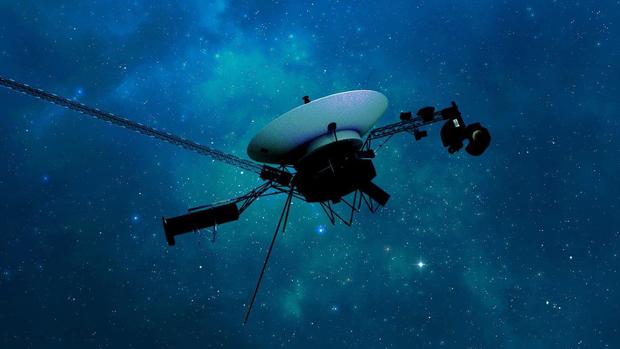
Last month, the craft's engineering team was able to confirm that the issue was related to one of the three onboard computers that make up Voyager 1's flight data subsystem. That system is what packages science and engineering data into a readable format before sending it to Earth. The team determined that "a single chip responsible for storing a portion of the (system's) memory," including some computer software code, wasn't working.
The chip couldn't be repaired and the code was too large to place in one new location, NASA said, so the team worked to relocate the affected code into multiple sections of the flight data subsystem. It took weeks to repackage the code, NASA said, and last Thursday, the new location was communicated to Voyager 1.
It takes about 22 and a half hours for a radio signal to reach Voyager 1 in interstellar space , or the space between stars, NASA said. On Saturday, the spacecraft's mission team received a response, confirming that the code modification had worked.
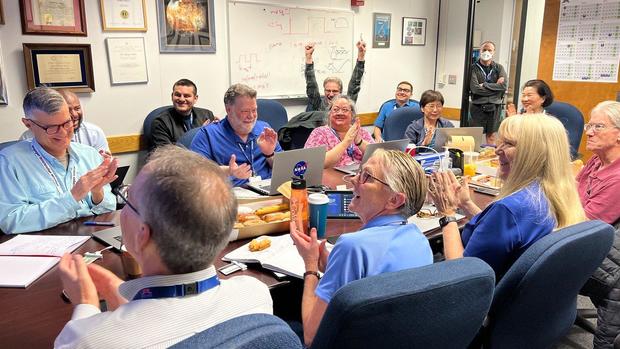
Engineers celebrated receiving new data for the first time in almost half a year, but the work isn't done yet. NASA said that in the coming weeks, the mission team will "relocate and adjust the other affected portions" of the software, including portions that will start returning science data. Meanwhile, Voyager 2 continues to operate with no issues, and both craft will continue to report back on the distant reaches of the solar system.
Kerry Breen is a reporter and news editor at CBSNews.com. A graduate of New York University's Arthur L. Carter School of Journalism, she previously worked at NBC News' TODAY Digital. She covers current events, breaking news and issues including substance use.
More from CBS News

Spacecraft spots "spiders" scattered across surface of Mars

Man who hoped to be first Black astronaut in 1960s finally heading to space

Olympic gold medalist Gabby Douglas competes for first time since 2016

Veteran taikonaut, 2 rookies launched to Chinese space station
- History of cooperation
- Areas of cooperation
- Procurement policy
- Useful links
- Becoming a supplier
- Procurement
- Rosatom newsletter
© 2008–2024Valtiollinen Rosatom-ydinvoimakonserni

- Rosatom Global presence
- Rosatom in region
- For suppliers
- Preventing corruption
- Press centre
Rosatom Starts Life Tests of Third-Generation VVER-440 Nuclear Fuel
- 16 June, 2020 / 13:00
This site uses cookies. By continuing your navigation, you accept the use of cookies. For more information, or to manage or to change the cookies parameters on your computer, read our Cookies Policy. Learn more
Air Show Report : MAKS 2005 Moscow International Aviation & Space Salon
Report and photos by Andrew Philpott ( view portfolio )
Home | Aircraft | Air Forces | Air Shows | Specials | Wallpapers | News | Quiz | Forum
Contact | About | FAQ | Updates | RSS Feeds | Links | Search
Copyright © 2002-2024 Niels Hillebrand . All Rights Reserved | Privacy & Cookie Policy | Terms of Service

Fact Sheets
Voyager rtg.
3D model of Voyager's RTG

You Might Also Like


Rosatom Starts Production of Rare-Earth Magnets for Wind Power Generation
TVEL Fuel Company of Rosatom has started gradual localization of rare-earth magnets manufacturing for wind power plants generators. The first sets of magnets have been manufactured and shipped to the customer.

In total, the contract between Elemash Magnit LLC (an enterprise of TVEL Fuel Company of Rosatom in Elektrostal, Moscow region) and Red Wind B.V. (a joint venture of NovaWind JSC and the Dutch company Lagerwey) foresees manufacturing and supply over 200 sets of magnets. One set is designed to produce one power generator.
“The project includes gradual localization of magnets manufacturing in Russia, decreasing dependence on imports. We consider production of magnets as a promising sector for TVEL’s metallurgical business development. In this regard, our company does have the relevant research and technological expertise for creation of Russia’s first large-scale full cycle production of permanent rare-earth magnets,” commented Natalia Nikipelova, President of TVEL JSC.
“NovaWind, as the nuclear industry integrator for wind power projects, not only made-up an efficient supply chain, but also contributed to the development of inter-divisional cooperation and new expertise of Rosatom enterprises. TVEL has mastered a unique technology for the production of magnets for wind turbine generators. These technologies will be undoubtedly in demand in other areas as well,” noted Alexander Korchagin, Director General of NovaWind JSC.
For reference:
TVEL Fuel Company of Rosatom incorporates enterprises for the fabrication of nuclear fuel, conversion and enrichment of uranium, production of gas centrifuges, as well as research and design organizations. It is the only supplier of nuclear fuel for Russian nuclear power plants. TVEL Fuel Company of Rosatom provides nuclear fuel for 73 power reactors in 13 countries worldwide, research reactors in eight countries, as well as transport reactors of the Russian nuclear fleet. Every sixth power reactor in the world operates on fuel manufactured by TVEL. www.tvel.ru
NovaWind JSC is a division of Rosatom; its primary objective is to consolidate the State Corporation's efforts in advanced segments and technological platforms of the electric power sector. The company was founded in 2017. NovaWind consolidates all of the Rosatom’s wind energy assets – from design and construction to power engineering and operation of wind farms.
Overall, by 2023, enterprises operating under the management of NovaWind JSC, will install 1 GW of wind farms. http://novawind.ru
Elemash Magnit LLC is a subsidiary of Kovrov Mechanical Plant (an enterprise of the TVEL Fuel Company of Rosatom) and its main supplier of magnets for production of gas centrifuges. The company also produces magnets for other industries, in particular, for the automotive
industry. The production facilities of Elemash Magnit LLC are located in the city of Elektrostal, Moscow Region, at the site of Elemash Machine-Building Plant (a nuclear fuel fabrication facility of TVEL Fuel Company).
Rosatom is a global actor on the world’s nuclear technology market. Its leading edge stems from a number of competitive strengths, one of which is assets and competences at hand in all nuclear segments. Rosatom incorporates companies from all stages of the technological chain, such as uranium mining and enrichment, nuclear fuel fabrication, equipment manufacture and engineering, operation of nuclear power plants, and management of spent nuclear fuel and nuclear waste. Nowadays, Rosatom brings together about 350 enterprises and organizations with the workforce above 250 K. https://rosatom.ru/en/

U.S. Added Less New Wind Power in 2021 Than the Previous Year — Here’s Why
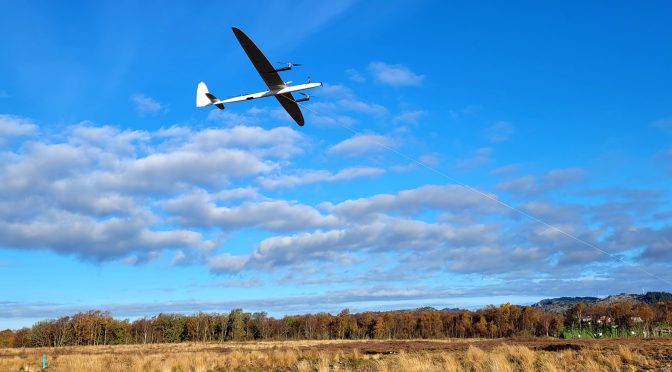
Airborne Wind Energy Developer Kitemill Prepares for 24HOUR Operation and Multi-Device Demonstrations

Vietnam's Largest Wind Power Plant Starts Operational

Australia Adopts Policy for Development of 1.2GW Wind Project

Vietnam Plans to Double Wind Power Generation by 2030

Developer Lines up Support for Vietnam Wind Build

For the first time Rosatom Fuel Division supplied fresh nuclear fuel to the world’s only floating nuclear cogeneration plant in the Arctic
The fuel was supplied to the northernmost town of Russia along the Northern Sea Route.

The first in the history of the power plant refueling, that is, the replacement of spent nuclear fuel with fresh one, is planned to begin before 2024. The manufacturer of nuclear fuel for all Russian nuclear icebreakers, as well as the Akademik Lomonosov FNPP, is Machinery Manufacturing Plant, Joint-Stock Company (MSZ JSC), a company of Rosatom Fuel Company TVEL that is based in Elektrostal, Moscow Region.
The FNPP includes two KLT-40S reactors of the icebreaking type. Unlike convenient ground-based large reactors (that require partial replacement of fuel rods once every 12-18 months), in the case of these reactors, the refueling takes place once every few years and includes unloading of the entire reactor core and loading of fresh fuel into the reactor.
The cores of KLT-40 reactors of the Akademik Lomonosov floating power unit have a number of advantages compared to the reference ones: a cassette core was used for the first time in the history of the unit, which made it possible to increase the fuel energy resource to 3-3.5 years between refuelings, and also reduce the fuel component of the electricity cost by one and a half times. The FNPP operating experience formed the basis for the designs of reactors for nuclear icebreakers of the newest series 22220. Three such icebreakers have been launched by now.
For the first time the power units of the Akademik Lomonosov floating nuclear power plant were connected to the grid in December 2019, and put into commercial operation in May 2020. The supply of nuclear fuel from Elektrostal to Pevek and its loading into the second reactor is planned for 2024. The total power of the Akademik Lomonosov FNPP, supplied to the coastal grid of Pevek without thermal energy consumption on shore, is about 76 MW, being about 44 MW in the maximum thermal power supply mode. The FNPP generated 194 million kWh according to the results of 2023. The population of Pevek is just a little more than 4 thousand, while the FNPP has a potential for supplying electricity to a city with a population of up to 100 thousand people. After the FNPP commissioning two goals were achieved. These include first of all the replacement of the retiring capacities of the Bilibino NPP, which has been operating since 1974, as well as the Chaunskaya TPP, which has already been operating for more than 70 years. Secondly, energy is supplied to the main mining companies in western Chukotka in the Chaun-Bilibino energy hub a large ore and metal cluster, including gold mining companies and projects related to the development of the Baimsk ore zone. In September 2023, a 110 kilovolt power transmission line with a length of 490 kilometers was put into operation, connecting the towns of Pevek and Bilibino. The line increased the reliability of energy supply from the FNPP to both Bilibino consumers and mining companies, the largest of which is the Baimsky GOK. The comprehensive development of the Russian Arctic is a national strategic priority. To increase the NSR traffic is of paramount importance for accomplishment of the tasks set in the field of cargo shipping. This logistics corridor is being developed due regular freight voyages, construction of new nuclear-powered icebreakers and modernization of the relevant infrastructure. Rosatom companies are actively involved in this work. Rosatom Fuel Company TVEL (Rosatom Fuel Division) includes companies fabricating nuclear fuel, converting and enriching uranium, manufacturing gas centrifuges, conducting researches and producing designs. As the only nuclear fuel supplier to Russian NPPs, TVEL supplies fuel for a total of 75 power reactors in 15 countries, for research reactors in nine countries, as well as for propulsion reactors of the Russian nuclear fleet. Every sixth power reactor in the world runs on TVEL fuel. Rosatom Fuel Division is the world’s largest producer of enriched uranium and the leader on the global stable isotope market. The Fuel Division is actively developing new businesses in chemistry, metallurgy, energy storage technologies, 3D printing, digital products, and decommissioning of nuclear facilities. TVEL also includes Rosatom integrators for additive technologies and electricity storage systems. Rosenergoatom, Joint-Stock Company is part of Rosatom Electric Power Division and one of the largest companies in the industry acting as an operator of nuclear power plants. It includes, as its branches, 11 operating NPPs, including the FNPP, the Scientific and Technical Center for Emergency Operations at NPPs, Design and Engineering as well as Technological companies. In total, 37 power units with a total installed capacity of over 29.5 GW are in operation at 11 nuclear power plants in Russia. Machinery Manufacturing Plant, Joint-Stock Company (MSZ JSC, Elektrostal) is one of the world’s largest manufacturers of fuel for nuclear power plants. The company produces fuel assemblies for VVER-440, VVER-1000, RBMK-1000, BN-600,800, VK-50, EGP-6; powders and fuel pellets intended for supply to foreign customers. It also produces nuclear fuel for research reactors. The plant belongs to the TVEL Fuel Company of Rosatom.
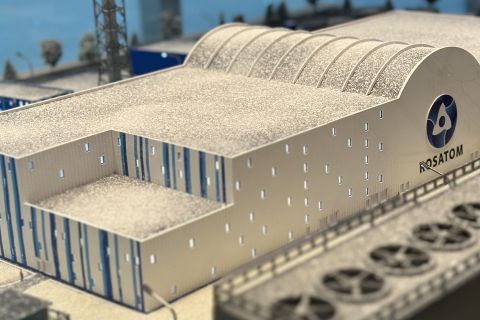
Rosatom obtained a license for the first land-based SMR in Russia
On April 21, Rosenergoatom obtained a license issued by Rostekhnadzor to construct the Yakutsk land-based SMR in the Ust-Yansky District of the Republic of Sakha (Yakutia).

ROSATOM and FEDC agree to cooperate in the construction of Russia's first onshore SNPP
ROSATOM and FEDC have signed a cooperation agreement to build Russia's first onshore SNPP in Yakutia.

Rosatom develops nuclear fuel for modernized floating power units
Rosatom has completed the development of nuclear fuel for the RITM-200S small modular reactor designed for the upgraded floating power units.

IMAGES
VIDEO
COMMENTS
Each RTG is made up of a radioisotope heat source, a thermoelectric converter, a gas pressure venting system, temperature transducers, connectors, a heat rejecting cylindrical container, and bracketry. The RTGs are mounted in tandem (end-to-end) on a deployable boom as part of the MM. The heat source radioisotopic fuel is Plutonium-238 in the ...
Powering the Voyager Spacecraft with Radiation: The RTG (Radioisotope Thermoelectric Generator) June 25, 2017 by Robin Mitchell The Voyager program was setup initially to study several of the outer planets by taking advantage of an alignment between Jupiter, Saturn, Uranus, and Neptune.
The Multihundred-Watt radioisotope thermoelectric generator (MHW RTG) is a type of US radioisotope thermoelectric generator (RTG) developed for the Voyager spacecraft, Voyager 1 and Voyager 2.. Radioisotope thermoelectric generators for the Voyager program. Each RTG has a total weight of 37.7 kg including about 4.5 kg of Pu-238 and uses 24 pressed plutonium-238 oxide spheres to provide enough ...
April 26, 2023. Each of NASA's Voyager probes are equipped with three radioisotope thermoelectric generators (RTGs), including the one shown here at NASA's Kennedy Space Center in Florida. The RTGs provide power for the spacecraft by converting the heat generated by the decay of plutonium-238 into electricity.
Each MHW RTG generated and output of 158 Watts electric at the beginning of mission, offering Voyager about 474 watts of electricity to power its science payload. The RTGs convert heat from the natural decay of plutonium oxide into useable power to power the spacecraft.
Voyager 2 is the only spacecraft to study all four of the solar system's giant planets at close range. The Voyagers are now exploring the outermost reaches of our sun's influence, where the solar wind mixes with the interstellar wind of our galaxy. Their long-lived power source has enabled these explorers to continue teaching us about our solar ...
Not Your 1970s RTG. While Voyager's MHW-RTG was developed specifically for the mission by NASA, its successor, the creatively titled general-purpose heat source RTG, was designed by General ...
The Next Gen RTG will employ heritage Silicon Germanium (SiGe) unicouples using a design that was successfully utilized in the Multi-Hundred Watt-RTG (MHW-RTG) that has operated for more than 45 years aboard Voyager 1 and 2, as well as the GPHS-RTGs . flown by Galileo, Ulysses, Cassini, and New Horizons. SiGe Unicouple. Credits: DOE/INL
3D model of Voyager's RTG NASA. Radioisotope Power Systems. Skip Navigation. menu close modal Resources Voyager RTG 3D model of Voyager's RTG. Downloads. ... This image shows the Multi-Mission Radioisotope Thermoelectric Generator for NASA'S Mars 2020 Perseverance rover during a fit check at the Kennedy Space Center in Florida on April 16-17, 2020.
The Voyager mission used the Multi-Hundred Watt (MHW) RTG with silicon-germanium (SiGe) thermoelectric materials that produced about 160 watts at 4 W/kg. The Galileo mission used the General Purpose Heat Source (GPHS) RTG with SiGe thermoelectric ... Multi-Mission Radioisotope Thermoelectric Generator (MMRTG) is being developed by Pratt ...
The probe and its twin, Voyager 2, are the only spacecraft to ever fly in interstellar space (the space between stars). Voyager 1 stopped sending readable science and engineering data back to Earth on Nov. 14, 2023, even though mission controllers could tell the spacecraft was still receiving their commands and otherwise operating normally.
Voyager's power supply comes from a radioisotope thermoelectric generator , which turns heat from the decay of a radioactive material into electricity to power the spacecraft. Due to the natural decay of the material inside the RTG, Voyager 2's power budget goes down by about 4 watts per year.
3 RTG's in each voyager spacecraft ~4.5kg of plutonium-238 per RTG (~0.57 watts of thermal power is generated per gram of plutonium-238) Each RTG generated about 2400 Watts of thermal power
A common RTG application is spacecraft power supply. Systems for Nuclear Auxiliary Power (SNAP) units were used for probes that traveled far from the Sun rendering solar panels impractical. As such, they were used with Pioneer 10, Pioneer 11, Voyager 1, Voyager 2, Galileo, Ulysses, Cassini, New Horizons, and the Mars Science Laboratory.
After 39 years of continuous operation in space, the output of the Voyager 1 & 2 spacecraft Radioisotope Thermoelectric Generator (RTG) power systems has decreased to the point where managing the power margin and maintaining thermal control has become increasingly difficult. As the total power dissipation in the bus has decreased, propellant line temperatures and margin above minimum Allowable ...
Radioisotope Thermoelectric Generators How It Works Radioisotope Thermoelectric Generators (RTGs) are lightweight, compact spacecraft power systems that are extraordinarily reliable. RTGs provide electrical power using heat from the natural radioactive decay of plutonium-238, in the form of plutonium oxide. The large difference in temperature between this hot fuel and the cold environment of ...
With a reliable RTG electrical power source, proven by the Voyager spacecraft to have an operating life of more than 45 years, we can expect many more years of exciting discoveries by New Horizons ...
The current RTG model is the Multi-Mission Radioisotope Thermoelectric Generator, or MMRTG. It is based on the type of RTG flown previously on the two Viking landers and the Pioneer 10 and 11 spacecraft (the SNAP-19 RTG). It is designed to be used in either the vacuum of space or within the atmosphere of a planet.
Voyager 1 and her sister spacecraft Voyager 2 were launched in 1977 to study Jupiter and Saturn. ... Powered by a nuclear battery, or Radioisotope Thermoelectric Generator (RTG), the spacecraft ...
Launched in 1977, Voyager I was part of a twin spacecraft mission to study the gas planets, flying past Jupiter and then Saturn, before heading off out into the unknown. Powered by a radioisotope ...
This illustration provided by NASA depicts Voyager 1. The most distant spacecraft from Earth stopped sending back understandable data in November 2023. Flight controllers traced the blank communication to a bad computer chip and rearranged the spacecraft's coding to work around the trouble. In mid-April 2024, NASA's Jet Propulsion ...
Voyager 1 stopped sending readable science and engineering data back to Earth on Nov. 14, 2023, even though mission controllers could tell the spacecraft was still receiving their commands and ...
NASA's Voyager 1 spacecraft was launched in 1977, about two weeks after the launch of its twin, Voyager 2. The spacecraft has spent over 45 years studying the outer solar system and has made ...
The NASA Voyager 1 craft is flying through interstellar space, a region with a high frequency of galactic cosmic rays that can harm the legendary spacecraft's aging instruments.
The life tests started after successful completion of hydraulic tests (hydraulic filling) of the mock-up with the aim to determine RK3+ hydraulic resistance. Life tests are carried out on a full-scale research hot run-in test bench V-440 and will last for full 1500 hours. The aim of tests is to study mechanical stability of RK3+ components ...
Air Show Report : MAKS 2005 Moscow International Aviation & Space Salon. Report by Andrew Philpott, all photos by author Financial reasons have restricted Russian Air Force equipment from attending airshows in the west for many years. We visited the best place in all of Russia to see military aircraft perform, the MAKS air show.
3D model of Voyager's RTG NASA. Radioisotope Power Systems. Skip Navigation. menu close modal Fact Sheets Voyager RTG 3D model of Voyager's RTG. Downloads. ... at NASA's Kennedy Space Center in Florida perform a fit check between the Mars 2020 Perseverance rover and its Multi-Mission Radioisotope Thermoelectric Generator on April 16-17, 2020.
06 Nov 2020 by Rosatom. TVEL Fuel Company of Rosatom has started gradual localization of rare-earth magnets manufacturing for wind power plants generators. The first sets of magnets have been manufactured and shipped to the customer. In total, the contract between Elemash Magnit LLC (an enterprise of TVEL Fuel Company of Rosatom in Elektrostal ...
21 April 2023 Rosatom obtained a license for the first land-based SMR in Russia. On April 21, Rosenergoatom obtained a license issued by Rostekhnadzor to construct the Yakutsk land-based SMR in the Ust-Yansky District of the Republic of Sakha (Yakutia).